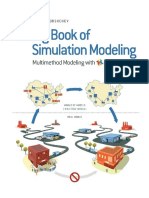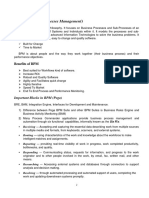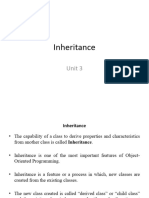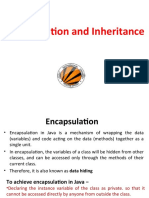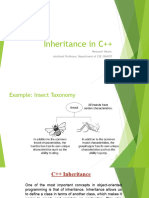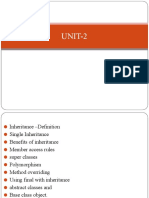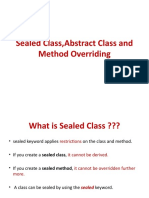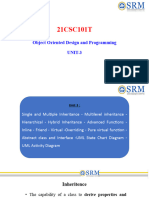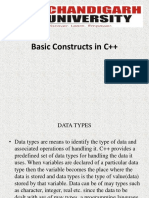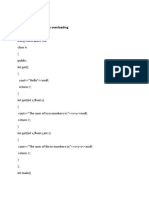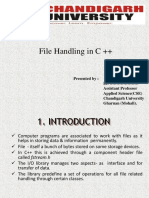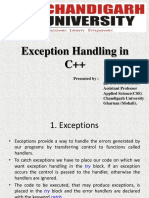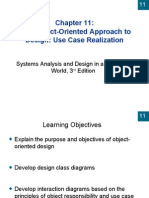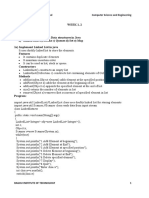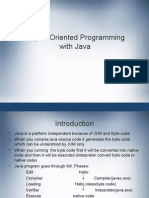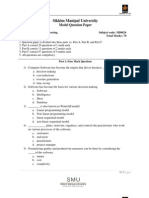0 ratings0% found this document useful (0 votes)
50 viewsInheritance: Presented By: Er. Simarpreet Kaur Subject: Programming in C++
Inheritance: Presented By: Er. Simarpreet Kaur Subject: Programming in C++
Uploaded by
Peace ReminderInheritance allows one class to acquire properties and characteristics from another class. The class that inherits properties is called the derived or child class, while the class being inherited from is called the base or parent class. Inheritance promotes code reuse and allows for method overriding to enable runtime polymorphism. A class can inherit from multiple base classes, which is known as multiple inheritance. Virtual base classes can be used to avoid duplicating base class instances when inheriting from more than one class with a common base.
Copyright:
© All Rights Reserved
Inheritance: Presented By: Er. Simarpreet Kaur Subject: Programming in C++
Inheritance: Presented By: Er. Simarpreet Kaur Subject: Programming in C++
Uploaded by
Peace Reminder0 ratings0% found this document useful (0 votes)
50 views30 pagesInheritance allows one class to acquire properties and characteristics from another class. The class that inherits properties is called the derived or child class, while the class being inherited from is called the base or parent class. Inheritance promotes code reuse and allows for method overriding to enable runtime polymorphism. A class can inherit from multiple base classes, which is known as multiple inheritance. Virtual base classes can be used to avoid duplicating base class instances when inheriting from more than one class with a common base.
Original Description:
c++
Original Title
05 Inheritance
Copyright
© © All Rights Reserved
Share this document
Did you find this document useful?
Is this content inappropriate?
Inheritance allows one class to acquire properties and characteristics from another class. The class that inherits properties is called the derived or child class, while the class being inherited from is called the base or parent class. Inheritance promotes code reuse and allows for method overriding to enable runtime polymorphism. A class can inherit from multiple base classes, which is known as multiple inheritance. Virtual base classes can be used to avoid duplicating base class instances when inheriting from more than one class with a common base.
Copyright:
© All Rights Reserved
0 ratings0% found this document useful (0 votes)
50 views30 pagesInheritance: Presented By: Er. Simarpreet Kaur Subject: Programming in C++
Inheritance: Presented By: Er. Simarpreet Kaur Subject: Programming in C++
Uploaded by
Peace ReminderInheritance allows one class to acquire properties and characteristics from another class. The class that inherits properties is called the derived or child class, while the class being inherited from is called the base or parent class. Inheritance promotes code reuse and allows for method overriding to enable runtime polymorphism. A class can inherit from multiple base classes, which is known as multiple inheritance. Virtual base classes can be used to avoid duplicating base class instances when inheriting from more than one class with a common base.
Copyright:
© All Rights Reserved
You are on page 1of 30
INHERITANCE
Presented by: Er. Simarpreet Kaur
Subject: Programming in C++
Inheritance
• Inheritance is the capability of one class to
acquire properties and characteristics from
another class. The class whose properties are
inherited by other class is called
the Parent or Base or Super class. And, the
class which inherits properties of other class is
called Child or Derived or Sub class.
• Inheritance makes the code reusable. When
we inherit an existing class, all its methods
and fields become available in the new class,
Purpose of Inheritance
• Code Reusability
• Method Overriding (Hence, Runtime
Polymorphism.)
• Use of Virtual Keyword
Syntax of Inheritance
• Syntax:
class Subclass_name : access_mode
Superclass_name
• While defining a subclass like this, the super
class must be already defined or atleast
declared before the subclass declaration.
• Access Mode is used to specify, the mode in
which the properties of superclass will be
inherited into subclass, public, privtate or
protected.
Derived Class
• A class can be derived from more than one
classes, which means it can inherit data and
functions from multiple base classes. To define
a derived class, we use a class derivation list to
specify the base class(es). A class derivation
list names one or more base classes.
• Syntax
class derived-class: access-specifier base-class
• Where access-specifier is one of public,
protected, or private, and base-class is the
Inheritance Visibility Mode
• Public inheritance
• Private inheritance
• Protected inheritance
Public inheritance
• This is the most used inheritance mode. In this
the protected member of super class becomes
protected members of sub class and public
becomes public.
• Syntax
class Subclass : public Superclass
Private Inheritance
• In private mode, the protected and public
members of super class become private
members of derived class.
• Syntax
class Subclass: Superclass // By default its
private inheritance
Protected Inheritance
• In protected mode, the public and protected
members of Super class becomes protected
members of Sub class.
• Syntax
class subclass : protected Superclass
Ambiguity in Inheritance
• In multiple inheritance, there may be
possibility that a class may inherit member
functions with same name from two or more
base classes and the derived class may not
have functions with same name as those of its
base classes. If the object of the derived class
need to access one of the same named
member function of the base classes then it
result in ambiguity as it is not clear to the
compiler which base’s class member function
Example
• A subclass can be derived from more than one superclass.
This is multiple inheritance.
• class A
{
public:
void show(){cout<<"A";}
};
class B
{
public:
void show() { cout<<"B"; }
};
• /* class C is multiple derived from its superclass A and B */
class C:public A, public B
{
};
int main()
{
Cont..
• Ambiguous call:
For the above sample
program, c.show() is ambiguous to get
resolved among candidate functions
B::show( ) and A::show( )
• Solution to ambiguous calls in multiple
inheritance:
Use scope resolution operator to explicitly
specify which base class's member function is
to be invoked.
Virtual Base Class
• When two or more objects are derived from a
common base class, we can prevent multiple
copies of the base class being present in an
object derived from those objects by declaring
the base class as virtual when it is being
inherited. Such a base class is known as virtual
base class. This can be achieved by preceding
the base class’ name with the word virtual.
• Virtual base classes are created before non-
virtual base classes, which ensures all bases
Example
class PoweredDevice
{
public:
PoweredDevice(int nPower)
{
cout << "PoweredDevice: " << nPower << endl;
}
};
class Scanner: public PoweredDevice
{
public:
Scanner(int nScanner, int nPower)
: PoweredDevice(nPower)
{
Cont..
class Printer: public PoweredDevice
{
public:
Printer(int nPrinter, int nPower)
: PoweredDevice(nPower)
{
cout << "Printer: " << nPrinter << endl;
}
};
class Copier: public Scanner, public Printer
{
public:
Copier(int nScanner, int nPrinter, int nPower)
: Scanner(nScanner, nPower), Printer(nPrinter, nPo
Cont..
• If we have to create a Copier class object,
by default you would end up with two
copies of the PoweredDevice class -- one
from Printer, and one from Scanner. This
has the following structure:
Then…how to use ‘virtual class’
• At the time, when only one copy of
PoweredDevice to be shared by both Scanner
and Printer. To share a base class, simply insert
the “virtual” keyword in the inheritance list of
the derived class. This creates what is called
a virtual base class, which means there is only
one base object that is shared. Here is the an
example (without constructors for simplicity)
showing how to use to virtual keyword to
create a shared base class:
Example
class PoweredDevice
{
};
class Scanner: virtual public PoweredDevice
{
};
class Printer: virtual public PoweredDevice
{
};
class Copier: public Scanner, public Printer
Function Overriding
• If we inherit a class into the derived class and
provide a definition for one of the base class's
function again inside the derived class, then
that function is said to be overridden, and this
mechanism is called Function Overriding
Requirements for overriding
• Inheritance should be there. Function
overriding cannot be done within a class. For
this we require a derived class and a base
class.
• Function that is redefined must have exactly
the same declaration in both base and derived
class, that means same name, same return
type and same parameter list.
Example
class Base
{
public: void show( )
{
cout << "Base class";
}
};
class Derived:public Base
{
public: void show( )
{
cout << "Derived Class";
}
}
Order of execution of Constructors
• During inheritance, base class may also
contain constructor and destructor.
In this case if you create an instance for the
derived class then base class constructor will
also be invoked and when derived instance is
destroyed then base destructor will also be
invoked and the order of execution of
constructors will be in the same order as their
derivation and order of execution of
destructors will be in reverse order of their
Example
using System;
namespace ProgramCall
{
class Base1
{
public Base1()
{
Console.WriteLine("Base Class Constructor");
}
~Base1()
{
Console.WriteLine("Base Class Destructor");
}
}
class Derived1 : Base1
{
public Derived1()
{
Console.WriteLine("Derived Class Constructor");
}
Cont..
class ConstructorInheritance
{
static void create()
{
Derived1 obj = new Derived1();
}
static void Main()
{
create();
GC.Collect();
Console.Read();
}
Output of Program
• Base Class Constructor
Derived Class Constructor
Derived Class Destructor
Base Class Destructor
Nesting of classes
A nested class is a class which is declared in
another enclosing class. A nested class is a
member and as such has the same access
rights as any other member. The members of
an enclosing class have no special access to
members of a nested class; the usual access
rules shall be obeyed.
Example 1: compilation without
error
#include<iostream>
using namespace std;
/* start of Enclosing class declaration */
class Enclosing {
int x;
/* start of Nested class declaration */
class Nested {
int y;
void NestedFun(Enclosing *e) {
cout<<e->x; // works fine: nested class can access
// private members of Enclosing class
}
}; // declaration Nested class ends here
}; // declaration Enclosing class ends here
int main()
Example 2: compilation with
error
#include<iostream>
using namespace std;
/* start of Enclosing class declaration */
class Enclosing {
int x;
/* start of Nested class declaration */
class Nested {
int y;
void NestedFun(Enclosing *e) {
cout<<e->x; // works fine: nested class can access
// private members of Enclosing class
}
}; // declaration Nested class ends here
}; // declaration Enclosing class ends here
int main()
Member access specifier
• Nested class declarations obey member
access specifiers, a private member class
cannot be named outside the scope of the
enclosing class, although objects of that class
may be manipulated:
example
class enclose {
struct nested { // private member
void g( ) { }
};
public:
static nested f( ) { return nested{ }; }
};
int main( )
{
//enclose::nested n1 = e.f( ); // error: 'nested' is
private
You might also like
- The Big Book of Simulation Mode - Andrei Borshchev PDFDocument444 pagesThe Big Book of Simulation Mode - Andrei Borshchev PDFIvanAndresLemus70% (10)
- Pega NotesDocument167 pagesPega NotesKumarReddy63% (8)
- 2100 (Aug15) Tutorials - Complete SetDocument16 pages2100 (Aug15) Tutorials - Complete SetLim Weng SeongNo ratings yet
- Chapter 3Document35 pagesChapter 3Ram BhardwajNo ratings yet
- 3CS4 OOPS Unit 3Document29 pages3CS4 OOPS Unit 3niworah679No ratings yet
- Oop 3Document35 pagesOop 3ayyamkhattak9No ratings yet
- InheritanceDocument12 pagesInheritanceSimran ShaikhNo ratings yet
- Lect03 - ClassesDocument10 pagesLect03 - Classes2151150038No ratings yet
- Puter Engineering - WWW - Rgpvnotes.inDocument15 pagesPuter Engineering - WWW - Rgpvnotes.indeepak kushwahNo ratings yet
- Note Oops and C#Document18 pagesNote Oops and C#Amod JoshiNo ratings yet
- Unit 4-1Document22 pagesUnit 4-1cja4326No ratings yet
- Inheritance PresentationDocument32 pagesInheritance PresentationDaniyal HussainNo ratings yet
- Chapter 5 1 C InheritenceDocument33 pagesChapter 5 1 C InheritenceDer EjartNo ratings yet
- OOP LAB 6 (Inheritance)Document16 pagesOOP LAB 6 (Inheritance)alielina53No ratings yet
- Inheritance Unit3Document44 pagesInheritance Unit3Siddharth JhaNo ratings yet
- Encapsulation and InheritanceDocument36 pagesEncapsulation and InheritanceVISHNU SHANKAR SINGHNo ratings yet
- Inheritance eDocument50 pagesInheritance eEr Ashish BahetiNo ratings yet
- Unit 2 Java NotesDocument75 pagesUnit 2 Java Notes198r1a0420No ratings yet
- Inheritence in C: - Submitted By: - Ankit Sharma - 100101037 - BacklogDocument20 pagesInheritence in C: - Submitted By: - Ankit Sharma - 100101037 - BacklogAnkit SharmaNo ratings yet
- Inheritance AbstractDocument22 pagesInheritance Abstractthorat_496512597No ratings yet
- Objects and ClassesDocument30 pagesObjects and ClassesWaguma LeticiaNo ratings yet
- Unit 3Document77 pagesUnit 3Jaswanth KumarNo ratings yet
- Lab Manual01 ADocument17 pagesLab Manual01 AMuzzamil EjazNo ratings yet
- Lecture 6 - InheritanceDocument28 pagesLecture 6 - Inheritanceadibsadman10No ratings yet
- InheritanceDocument36 pagesInheritancepritamNo ratings yet
- Unit1 Part3Document38 pagesUnit1 Part3khanalpratima03No ratings yet
- Inheritance in OopDocument21 pagesInheritance in Oopchicken65 85No ratings yet
- C++ NotesDocument18 pagesC++ NotesjavedNo ratings yet
- Purpose of Inheritance in C++Document16 pagesPurpose of Inheritance in C++hariniNo ratings yet
- C#inheritanceDocument8 pagesC#inheritanceshwanasNo ratings yet
- Advantages of InheritanceDocument4 pagesAdvantages of InheritanceGoldy Batra100% (1)
- UNIT 3 Part 1Document33 pagesUNIT 3 Part 1kilomediaofficialNo ratings yet
- Programming in Java: InheritanceDocument36 pagesProgramming in Java: InheritanceVinay Kumar Vinny PanthaganiNo ratings yet
- 21csc101t Oodp Unit-3Document147 pages21csc101t Oodp Unit-3pk6048No ratings yet
- Inheritance Mod 3 (Part 1)Document13 pagesInheritance Mod 3 (Part 1)dcsoni6350No ratings yet
- Inheritance BasicsDocument30 pagesInheritance BasicsGanesh NelluriNo ratings yet
- InheritanceDocument36 pagesInheritanceadarsh rajNo ratings yet
- InheritanceDocument70 pagesInheritanceSanyam SainiNo ratings yet
- Inheritance in C#: Date-14-04-2011Document52 pagesInheritance in C#: Date-14-04-2011Niyati SainiNo ratings yet
- Java Unit 2Document35 pagesJava Unit 2hthjyhNo ratings yet
- Unit 3 - OOPDocument15 pagesUnit 3 - OOPKamini SalunkheNo ratings yet
- CPP InheritanceDocument4 pagesCPP InheritanceDusan Petrovic100% (1)
- Lab 01Document13 pagesLab 01api-257313790No ratings yet
- Inheritance in JavaDocument13 pagesInheritance in JavaKrishna paulNo ratings yet
- Unit 3 InheritanceDocument11 pagesUnit 3 InheritanceAnupama MishraNo ratings yet
- C++ InheritanceDocument5 pagesC++ InheritanceSamia ShahNo ratings yet
- Inheritance in C#Document53 pagesInheritance in C#AnikNo ratings yet
- 21csc101t Oodp Unit-3Document147 pages21csc101t Oodp Unit-3sreeramvrkumarNo ratings yet
- Programming in Java: InheritanceDocument36 pagesProgramming in Java: InheritanceAjayNo ratings yet
- JavaUnit2 3Document52 pagesJavaUnit2 3Manoj BhakuniNo ratings yet
- Inheritance Group3Document41 pagesInheritance Group3breeNo ratings yet
- Unit 4 Inheritance: Tanima Thakur UID-23532Document19 pagesUnit 4 Inheritance: Tanima Thakur UID-23532shreyansh gaddamwarNo ratings yet
- Sealed ClassDocument21 pagesSealed ClassfNo ratings yet
- Sub Class: The Class That Inherits Properties From Another Class Is Called Sub ClassDocument29 pagesSub Class: The Class That Inherits Properties From Another Class Is Called Sub ClassP.M. Movies Clips WorldNo ratings yet
- L6 - ClassDocument40 pagesL6 - Classalamin shawonNo ratings yet
- 21CSC101T: Object Oriented Design and Programming UNIT-3Document147 pages21CSC101T: Object Oriented Design and Programming UNIT-3mainak1331senNo ratings yet
- Java Programming6Document6 pagesJava Programming6preetham aNo ratings yet
- 21csc101t Oodp Unit-3Document147 pages21csc101t Oodp Unit-3sreeramvrkumarNo ratings yet
- 21CSC101T Oodp Unit-3Document151 pages21CSC101T Oodp Unit-3Utkarsh JaiswalNo ratings yet
- Polymorphism & Inheritance in C#Document50 pagesPolymorphism & Inheritance in C#eshamuNo ratings yet
- Window Programming Ch3 C# OO Concepts ModifiedDocument12 pagesWindow Programming Ch3 C# OO Concepts ModifiedAbdurezak AhmedNo ratings yet
- Object Oriented Programming Inheritance: Fundamentals and ApplicationsFrom EverandObject Oriented Programming Inheritance: Fundamentals and ApplicationsNo ratings yet
- Java Programming Tutorial With Screen Shots & Many Code ExampleFrom EverandJava Programming Tutorial With Screen Shots & Many Code ExampleNo ratings yet
- Chapter 3Document26 pagesChapter 3Peace ReminderNo ratings yet
- Quiz CST 152Document153 pagesQuiz CST 152Peace Reminder0% (1)
- Question Details of Subject:QUIZ-CSP-157: Total Questions: 0Document1 pageQuestion Details of Subject:QUIZ-CSP-157: Total Questions: 0Peace ReminderNo ratings yet
- Basic Constructs in C++Document54 pagesBasic Constructs in C++Peace ReminderNo ratings yet
- 1) WAP For Function OverloadingDocument34 pages1) WAP For Function OverloadingPeace ReminderNo ratings yet
- File Handling in C ++Document74 pagesFile Handling in C ++Peace ReminderNo ratings yet
- Pointers and Dynamic Memory AllocationDocument96 pagesPointers and Dynamic Memory AllocationPeace ReminderNo ratings yet
- Constructors: Presented By: Er. Simarpreet Kaur Subject: Programming in C++Document23 pagesConstructors: Presented By: Er. Simarpreet Kaur Subject: Programming in C++Peace ReminderNo ratings yet
- Operator Overloading: Presented By: Er. Simarpreet Kaur Subject: Programming in C++Document10 pagesOperator Overloading: Presented By: Er. Simarpreet Kaur Subject: Programming in C++Peace ReminderNo ratings yet
- Function Overloading: Presented By: Er. Simarpreet Kaur Subject: Programming in C++Document8 pagesFunction Overloading: Presented By: Er. Simarpreet Kaur Subject: Programming in C++Peace ReminderNo ratings yet
- Exception Handling in C++Document30 pagesException Handling in C++Peace ReminderNo ratings yet
- Java FDocument42 pagesJava Fneeraj kumarNo ratings yet
- Unit Test 2 - PP - WS - 2021-QP1Document4 pagesUnit Test 2 - PP - WS - 2021-QP1Sailakshmi ReddyNo ratings yet
- The Object-Oriented Approach To Design: Use Case RealizationDocument62 pagesThe Object-Oriented Approach To Design: Use Case RealizationpearlkikNo ratings yet
- Spring NotesDocument211 pagesSpring NotesrahulNo ratings yet
- ZooDocument98 pagesZooPankaj Rawat50% (2)
- Unit-3 NotesDocument68 pagesUnit-3 NotesIpshita TiwariNo ratings yet
- C NET Material PDFDocument548 pagesC NET Material PDFBhagyasri Annam JaldawarNo ratings yet
- Java MySQL Database ConnectionDocument5 pagesJava MySQL Database ConnectionHulom, Josuan LeonardoNo ratings yet
- Hadoop Lab ManualDocument92 pagesHadoop Lab ManualkoushikNo ratings yet
- Unit 20 Assignment 2Document16 pagesUnit 20 Assignment 2kcasNo ratings yet
- Object-Oriented Programming With JavaDocument21 pagesObject-Oriented Programming With JavasoundarpandiyanNo ratings yet
- Syed Shams Haider 203 Lab Report 07Document24 pagesSyed Shams Haider 203 Lab Report 07Syed ShamsNo ratings yet
- DLMS Blue Book 4Th Edition InternetDocument97 pagesDLMS Blue Book 4Th Edition InternetHung NguyenNo ratings yet
- Online Tax Management System Project ReportDocument174 pagesOnline Tax Management System Project ReportANDRU PRADHEEPNo ratings yet
- OOP Principles UML Class Diagrams: Object-Oriented Software Development SE 450 - Winter 2021Document74 pagesOOP Principles UML Class Diagrams: Object-Oriented Software Development SE 450 - Winter 2021Manoj VemuriNo ratings yet
- Java Programming For BeginnersDocument3 pagesJava Programming For Beginnersazphyo100% (1)
- Logic and Process Automation II PDFDocument26 pagesLogic and Process Automation II PDFSchubert TonarelliNo ratings yet
- SAP ABAP Webdynpro Interview Questions and AnswersDocument13 pagesSAP ABAP Webdynpro Interview Questions and AnswerskrishnamavuriNo ratings yet
- DOC-20241103-WA0000.Document3 pagesDOC-20241103-WA0000.abirpiyada115No ratings yet
- Abap NotesDocument57 pagesAbap NotesDhruva Nanda100% (1)
- Training and PlacementDocument48 pagesTraining and PlacementMohammed JamsheedNo ratings yet
- 721112ex PDFDocument40 pages721112ex PDFJawad Iqbal100% (1)
- Airline Reservation SystemsDocument39 pagesAirline Reservation SystemsNG COMPUTERNo ratings yet
- Programming Assignment I: 1 Overview of The Programming ProjectDocument3 pagesProgramming Assignment I: 1 Overview of The Programming ProjectHoussem NasriNo ratings yet
- MI0024 Software Engineering-Model Question PaperDocument7 pagesMI0024 Software Engineering-Model Question PaperSarika NairNo ratings yet
- NIIT PimpriDocument8 pagesNIIT PimpriAnujith AnuNo ratings yet
- Computer Science Notes PDFDocument14 pagesComputer Science Notes PDFArchisha KhareNo ratings yet
